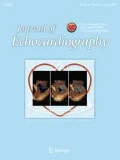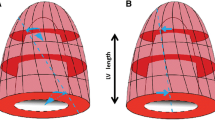Abstract
Background
In this study, three-dimensional torsion angle of myocardium was extracted by two-dimensional images of the left ventricle at three levels of base, mid, and apex of interventricular septum wall.
Methods
Two-dimensional echocardiography images of long- and short-axis views of healthy men were synchronized using an electrocardiogram of each individual and processed. Interventricular septum wall motion at three levels of base, mid, and apex were measured using a motion-detection algorithm throughout three cardiac cycles. Considering position vectors in long and short-axis views, the three-dimensional torsion angle is extracted throughout the cardiac cycle.
Results
The average and standard deviation of ΦM during three cardiac cycles for interventricular septal wall in healthy individuals in this study are estimated as 16.3 ± 3.0° at base level, 22.8 ± 5.0° at mid level, and 14.6 ± 5.8° at apex level of septum wall, respectively.
Conclusions
This angle suggested for examination of regional and global biomechanical behavior of myocardium in different pathologic conditions.






Similar content being viewed by others
References
Taber LA, Yang M, Podszus WW. Mechanics of ventricular torsion. J Biomech. 1996;29:745–52.
Sengupta pp, Krishnamoorthy VK, Korinek J, et al. Left ventricular form and function revisited: applied translational science to cardiovascular ultrasound imaging. J Am Soc Echocardiogr. 2007;20:539–51.
Torrent-Guasp F, Ballester M, Buckberg GD, et al. Spatial orientation of the ventricular muscle band: physiologic contribution and surgical implications. J Thorac Cardiovasc Surg. 2001;122:389–92.
Esch BT, Warburton DER. Left ventricular torsion and recoil: implications for exercise performance and cardiovascular disease. J Appl Physiol. 2009;106:362–9.
Hansen DE, Daughters GT, Alderman EL, et al. Effect of acute human cardiac allograft rejection on left ventricular systolic torsion and diastolic recoil measured by intramyocardial markers. Circulation. 1987;76:998–1008.
Garot J, Pascal O, Diebold B, et al. Alterations of systolic left ventricular twist after acute myocardial infarction. Am J Physiol Heart Circ Physiol. 2002;282:357–62.
Helle-Valle T, Remme EW, Lyseggen E, et al. Clinical assessment of left ventricular rotation and strain: a novel approach for quantification of function in infarcted myocardium and its border zones. Am J Physiol Heart Circ Physiol. 2009;297:H257–67.
Notomi Y, Lysyansky P, Setser RM, et al. Measurement of ventricular torsion by two-dimensional ultrasound speckle tracking imaging. J Am Coll Cardiol. 2005;45:2034–41.
Gustafsson U, Lindqvist P, Morner S, et al. Assessment of regional rotation patterns improves the understanding of the systolic and diastolic left ventricular function: an echocardiographic speckle-tracking study in healthy individuals. Eur J Echocardiogr. 2009;10:56–61.
Arab-Baferania Z, Mokhtari-Dizajia M, Roshanalib F. Extraction of left-ventricular torsion angle from the long-axis view by block-matching algorithm: comparison with the short-axis view. Ultrasonics. 2013;53:552–60.
Adhyapak SM, Parachuri VR. Architecture of the left ventricle: insights for optimal surgical ventricular restoration. Heart Fail Rev. 2010;15:73–83.
Anderson K, Wilson PW, Odell PM, et al. An updated coronary risk profile. Statement for health professionals. Cir J. 1991;83:356–62.
Cerqueira MD, Weissman NJ, Dilsizian V, et al. American Heart Association Writing Group on myocardial segmentation and registration for cardiac imaging. Standardized myocardial segmentation and nomenclature for tomographic imaging of the heart. A statement for healthcare professionals from the Cardiac Imaging Committee of the Council on Clinical Cardiology of the American Heart Association. Int J Cardiovasc Imaging. 2002;18:539–42.
Rahmani-Cherati T, Mokhtari Dizaji M, Vajhi A, et al. Extraction of instantaneous changes of arterial walls with sequential ultrasound images. J Med Ultrasound. 2011;38:81–7.
Soleimani E, Mokhtari Dizaji M, Saberi H. Carotid artery wall motion estimation from consecutive ultrasonic images: Comparison between block-matching and maximum-gradient algorithms. J Teh Univ Heart Ctr. 2011;6:72–8.
Chen EJ, Jenkins WK, O’Brien WD. The impact of various imaging parameters on ultrasonic displacement and velocity estimates. IEEE Trans Ultrason Ferroelectr Freq Control. 1994;41:293–301.
Yeung F, Levinson SF, Fu D, et al. Feature-adaptive motion tracking of ultrasound image sequences using a deformable mesh. IEEE Trans Med Imaging. 1998;17:945–56.
Acknowledgments
This study was approved and funded by Faculty of Medical Sciences, Tarbiat Modares University.
Conflict of interest
Mosayyeb Mobasheri, Manijhe Mokhtari-Dizaji, and Faride Roshanali declare that they have no conflicts of interest to declare.
Human rights statements and informed consent
All procedures followed were in accordance with the ethical standards of the responsible committee on human experimentation (the medical ethics committee of Tarbiat Modares University, Iran) and with the Helsinki Declaration of 1975, as revised in 2000. Informed consent was obtained from all patients included in the study.
Author information
Authors and Affiliations
Corresponding author
Rights and permissions
About this article
Cite this article
Mobasheri, M., Mokhtari-Dizaji, M. & Roshanali, F. Measurement of ventricular three-dimensional torsion. J Echocardiogr 13, 59–65 (2015). https://doi.org/10.1007/s12574-015-0241-9
Received:
Revised:
Accepted:
Published:
Issue Date:
DOI: https://doi.org/10.1007/s12574-015-0241-9




